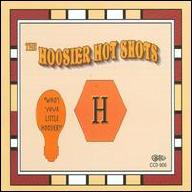They stayed with Buzzington until he disbanded the group in 1929, the three vowing to stay in touch, and playing together in various on and off situations. In 1932, the Trietsch Brothers and Ward -- their stage moniker at the time -- were broadcasting over WOWO in Fort Wayne, IN. Doing a charity broadcast to help Ohio River Valley flood victims, they quickly found and developed their style doing novelty renditions of good-time songs, playing one after another during the course of the radio-thon. They picked up a 15-minute sustaining program on the station for no pay but with the chance to promote their own live appearances over the airwaves. They soon came to even wider prominence via their radio appearances on the National Barn Dance, broadcast over powerful station WLS in Chicago. The show was the first of its type to be broadcast and reach a wide audience, predating the subsequent success of Nashville's Grand Ole Opry and counting a young Gene Autry, Lulubelle Scotty, and Red Foley among its many stars.
The show became a radio staple, broadcasting every Saturday night across the country for over 35 years. The trio -- under their new name, the Hoosier Hot Shots -- were an immediate hit, considering it an honor to be hooked up with the most prestigious show in country music. But the group just as quickly moved over to a regular guest spot on the Uncle Ezra Pinex Cough Syrup program, and when Uncle Ezra secured a national spot with NBC, he took the Hot Shots with him, and the group's national success was quickly assured.
They started making records around this time, and the Hot Shots couldn't have asked for a more sympathetic producer on their sessions than Art Satherly. Satherly, a distinguished Englishman, was in charge of Columbia Records' (at that time ARC) country and blues A&R division. As Gabe Ward put it, "What Art Satherly wanted on record was out visualness; he was trying to get that through. And he succeeded with us, because we were about the only people who could make people laugh after only four bars of music!" Satherly, for his part, would strip down to his shirt, put a bath towel around his neck, and go into the studio and dance to illustrate the tempo he wanted the Hot Shots to record at. The formula -- with Gabe calling out, "Are you ready, Hezzie?" at the start of each tune -- was a wildly successful one, with the band's records fitting comfortably on jukeboxes around the country in the "novelty dance" category. Among their hits were I Like Bananas Because They Have No Bones, The Coat and Pants Do All the Work, and From the Indies to the Andies in His Undies, exactly the type of tunes that fitted the group like a glove. "We were tops in the novelty field," Ward would later reminisce, "all because of Art Satherly. He had the nerve to put them on the jukeboxes, even though they weren't always the top tunes. We'd do it for Art Satherly, with a beat for the jukeboxes." What Ward also fails to mention, however, is the group's tireless promotion of those records, making in-store appearances at all the Sears and Roebuck outlets nationwide when their 78s started appearing on the company's budget label, Perfect.
By the late '30s the Hot Shots started making movie appearances, debuting with a turn in #In Old Monterey in 1939. The success of this and a couple others led the group to give up their sustaining radio spot with Uncle Ezra, relocating to the West Coast after World War II. Signing a movie deal with Columbia Pictures, the Hot Shots would go on to appear in 22 films into the early '50s. With the advent of changing tastes and the rise of television, the boys' star fell into eclipse somewhat, although they found steady work on the Nevada gambling casino circuit. The group soldiered on into the '70s, when Paul Hezzie Trietsch's death broke up the original group. Although nowhere near as wild as Spike Jones, nor possessing the "thinking man's hillbillies" personas of Homer Jethro, it is impossible to think of either of those two acts existing -- much less prospering and finding an audience -- without the groundbreaking efforts of the Hoosier Hot Shots. ~ Cub Koda, Rovi


















